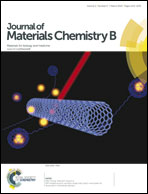Effects of self-assembled fibers on the synthesis, characteristics and biomedical applications of CCAG hydrogels
Abstract
CS–HLC–HA–β-GP (chitosan–human-like collagen–hyaluronic acid–β-sodium glycerophosphate) hydrogels were prepared based on the self-assembly of CS–HLC–HA (CCA) fibers. The effects of the fibers on the synthesis, characteristics and biomedical applications of CS–HLC–HA–β-GP (CCAG) hydrogels were studied for various HA contents. The synthesis mechanism of the novel CCAG hydrogel was explored using Fourier transform infrared spectroscopy (FT-IR) and X-ray photoelectron spectroscopy (XPS). The hydrogels were characterized by a swelling test, gelling time and enzymatic treatments. The results indicated that a new amide bond (–CONH) and –NRH2+ were formed. The gelling time and swelling behaviors were dependent on the intertwining, overlap and adsorption of the polymer chains at various temperatures and pH. Furthermore, biomedical applications were evaluated by transmission electron microscopy (TEM), immunohistochemical analysis and haematoxylin and eosin (H&E) staining. The effect of the fibers on the histocompatibility of the hydrogels revealed that the fibers inside the hydrogel pores reduced the quantity of macrophages, decreased the degree of inflammation, and improved the anti-degradation of the modified hydrogels. This type of new hydrogel emerges as an interesting injectable filling biomaterial for tissue engineering.


 Please wait while we load your content...
Please wait while we load your content...